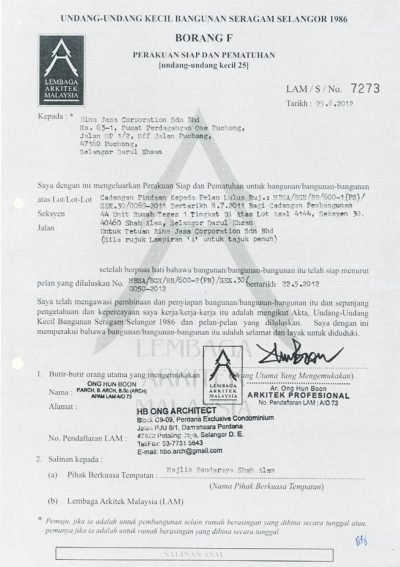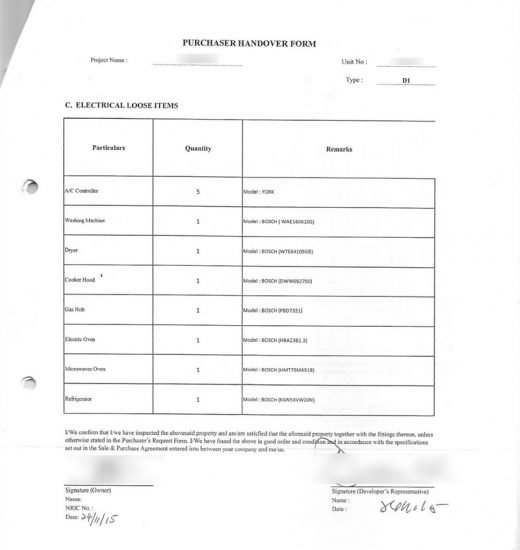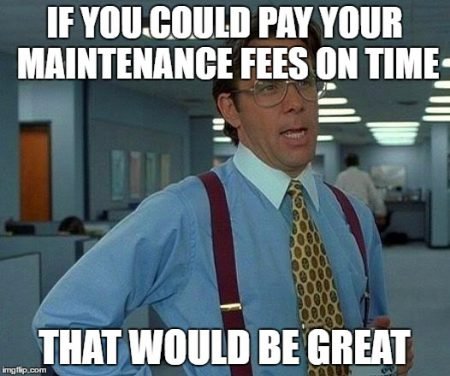The day has arrived. After months – maybe years – of waiting, you’re finally ready to receive the keys to your home sweet home. So awesome, right? 😀
Hold your horses (and keys) though, because there are several more steps before you can go ahead and move into your completed crib. Here’s a quick guide on what to do and take note of, during the process of receiving the keys from the developer, to furnishing your unit for own stay:
1. Delivery of Vacant Possession
Delivery of Vacant Possession is when the property is ready to be handed to you. This usually happens 24 to 36 months from when you first paid the down payment and signed the sales and purchase agreement (SPA). By this time, construction work should have ended and the building is complete and ready to be lived in, barring some decorative items such as landscaping. When the property is about 70% completed, you will receive a letter from the developer to set a date when you can take Delivery of Vacant Possession. When the property is finally completed, you will need to go to the sales office to formally collect the property. On the same day you collect the property, you will also receive a copy of the Certificate of Completion and Compliance (CCC).

Waiting to be informed about collecting your keys like…
2. Certificate of Completion and Compliance (CCC)
Formerly known as the certificate of fitness (CF), the CCC is a document released by the local authority council that declares a particular property is completed and safe to be occupied. It is also known as Borang F, Perakuan Siap dan Pematuhan. Legally speaking, the CCC is a requirement stated in the SPA. So, when you take possession of the property, make sure that your house has already been granted a CCC.

Example of a Certificate of Completion and Compliance (CCC) or Borang F -Photo from Binajasa
3. Handover Documents
When you go to the developer’s office to take delivery of vacant possession, you’ll need to sign several documents as proof that you’ve received the keys to your property. Once you sign the documents and write down the date, the Defect Liability Period for your property begins. Part of this set of documents will include a simple list of the lighting fixtures, appliances, electrical sockets and other built-ins. The format will vary, but it should generally list out the items that are included in your unit, so check it carefully.

Sample of a property handover form that has a checklist of items included in the property -Photo from RecomN
4. Defect Liability Period
Think of the Defect Liability Period as a “warranty” period for your property. Homeowners will be given 18 to 24 months to check and report any defects, poor workmanship or irregularities from the SPA. However, it’s best to do a thorough check as soon as possible, as the house will be empty and thus easier to spot and fix any issues before moving in.

Prepare a list of defects and issues -Photo from Nelson Building Reports
The developer will usually provide a Defect Complaint Form that lists the common areas in the house. Use it to mark out any problems you find, such as loose electrical sockets, misaligned flooring, etc. Even if it’s a small problem, make a note about it, as it could become a bigger problem that will cost more to fix later on.

It’s also a good idea of mark out any property defects like this -Photo from lowyat.net
5. Management Office Contact
This is if you’ve purchased an apartment, condominium or other type of strata unit. The shared common areas and maintenance of the property will be managed by a new entity known as the management office. Usually, the management will be selected by the developer, before the residential committee is set up. You will need their contact details for assistance on the monthly maintenance fees, sinking fund collection as well as the rules and regulation of the property. Generally speaking, when you sign the property handover form for a condominium, it will also include an invoice for the first 3 months of property maintenance.

Management be like…
 6. Utilities
6. Utilities
This part may vary according to developers. Some will plan ahead and ask you to apply for utilities even while the property is being built, while others may ask you to do it after. Either way, it’s best to get these done ASAP, because we can’t exactly stay in a house without electricity, water, and wi-fi. Typical utilities applications include:
- Electricity supply: Tenaga Nasional Bhd’s new account application
- Water supply: Syabas water supply application (Kuala Lumpur, Putrajaya and Selangor)
- Gas supply (if piped in): Gas Malaysia’s natural gas supply application
- Internet: Telekom Malaysia (or other home internet providers) new account application
7. Interior Planning
Now that most of the major developer-related items have been sorted out, it’s time to prepare your dream home. Most homes nowadays – especially condominiums and serviced apartments – usually come with fixtures like air-conditioning, water heaters, even kitchen appliances. It’s best if you can decide the renovations that you want before moving in, as it will be much easier for the contractors and interior designers to do their work in an empty house. Remember, you’ll need to leave a deposit cheque with the management office before you carry out any deliveries or renovation work.

We hope this problem doesn’t happen to you. Really.
8. Cleaning
All the dust and dirt from renovations and moving in is sure to get everywhere, so it’s time to clean up your brand spankin’ new home before officially moving in and inviting everyone over for a party. You’ll need quite a lot of elbow grease to do the cleaning by yourself, or if that’s too much work, you should hire a team of professional cleaners.
Don’t underestimate the effort needed to clean up a new home. It’s not just a matter of mopping the floors and wiping the shelves. Major cleaning can include tile and grout cleaning, chemical cleaning for the windows and sliding door, and sanitising your home before the housewarming party.

Or if you had an army of Minions to do your cleaning.
Once all that is done, you’re all set! Time to invite your family, friends, random neighbours, and pop the fizzy drinks!






